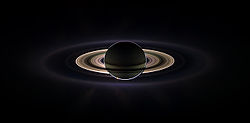
Forward scatter
Encyclopedia

Telecommunication
Telecommunication is the transmission of information over significant distances to communicate. In earlier times, telecommunications involved the use of visual signals, such as beacons, smoke signals, semaphore telegraphs, signal flags, and optical heliographs, or audio messages via coded...
and astronomy
Astronomy
Astronomy is a natural science that deals with the study of celestial objects and phenomena that originate outside the atmosphere of Earth...
, forward scatter is the deflection
Deflection (physics)
In physics deflection is the event where an object collides and bounces against a plane surface.In such collisions involving a sphere and a plane, the collision angle formed with the surface normal must equal the bounce angle , \alpha = \beta.Magnetic deflection refers to Lorentz forces acting...
—by diffraction
Diffraction
Diffraction refers to various phenomena which occur when a wave encounters an obstacle. Italian scientist Francesco Maria Grimaldi coined the word "diffraction" and was the first to record accurate observations of the phenomenon in 1665...
, nonhomogeneous refraction
Refraction
Refraction is the change in direction of a wave due to a change in its speed. It is essentially a surface phenomenon . The phenomenon is mainly in governance to the law of conservation of energy. The proper explanation would be that due to change of medium, the phase velocity of the wave is changed...
, or nonspecular reflection
Reflection (physics)
Reflection is the change in direction of a wavefront at an interface between two differentmedia so that the wavefront returns into the medium from which it originated. Common examples include the reflection of light, sound and water waves...
by particulate matter of dimensions that are large with respect to the wavelength
Wavelength
In physics, the wavelength of a sinusoidal wave is the spatial period of the wave—the distance over which the wave's shape repeats.It is usually determined by considering the distance between consecutive corresponding points of the same phase, such as crests, troughs, or zero crossings, and is a...
in question but small with respect to the beam diameter
Beam diameter
The beam diameter or beam width of an electromagnetic beam is the diameter along any specified line that is perpendicular to the beam axis and intersects it. Since beams typically do not have sharp edges, the diameter can be defined in many different ways. Five definitions of the beam width are in...
—of a portion of an incident electromagnetic wave, in such a manner that the energy so deflected propagates in a direction that is within 90° of the direction of propagation
Wave propagation
Wave propagation is any of the ways in which waves travel.With respect to the direction of the oscillation relative to the propagation direction, we can distinguish between longitudinal wave and transverse waves....
of the incident wave (i.e., the phase angle
Phase angle (astronomy)
Phase angle in astronomical observations is the angle between the light incident onto an observed object and the light reflected from the object...
is greater than 90°).
The scattering
Scattering
Scattering is a general physical process where some forms of radiation, such as light, sound, or moving particles, are forced to deviate from a straight trajectory by one or more localized non-uniformities in the medium through which they pass. In conventional use, this also includes deviation of...
process may be polarization-sensitive, i.e., incident waves that are identical in every respect but their polarization may be scattered differently.
Comets
Forward scattering (back-lighting) can make a comet appear significantly brighter because the dust and ice crystals are reflecting and enhancing the apparent brightness of the comet by scattering that light towards us. Comets studied forward-scattering in visible-thermal photometry include C/1927 X1 (Skjellerup–Maristany), C/1975 V1 (West)Comet West
Comet West formally designated C/1975 V1, 1976 VI, and 1975n, was a spectacular comet, sometimes considered to qualify for the status of "great comet".- Discovery :...
, and C/1980 Y1 (Bradfield). Comets studied forward-scattering in SOHO
Solar and Heliospheric Observatory
The Solar and Heliospheric Observatory is a spacecraft built by a European industrial consortium led by Matra Marconi Space that was launched on a Lockheed Martin Atlas IIAS launch vehicle on December 2, 1995 to study the Sun, and has discovered over 2100 comets. It began normal operations in May...
non-thermal C3 coronograph photometry include 96P/Machholz
96P/Machholz
Comet 96P/Machholz or 96P/Machholz 1 is a short-period comet discovered on May 12, 1986 by amateur astronomer Donald Machholz in Loma Prieta, California. Comet 96P/Machholz will next come to perihelion on July 14, 2012....
and C/2004 F4 (Bradfield). The brightness of the great comet
Great comet
A Great Comet is a comet that becomes exceptionally bright. There is no official definition; often the term will be attached to comets that become bright enough to be noticed by casual observers who are not actively looking for them, and become well known outside the astronomical community. Great...
s C/2006 P1 (McNaught) and Comet Skjellerup–Maristany near perihelion were enhanced by forward scattering. During the night of 1861 June 30-July 1, the famed comet observer J. F. Julius Schmidt
Johann Friedrich Julius Schmidt
Johann Friedrich Julius Schmidt was a German astronomer and geophysicist.-Biography:...
watched in awe as the great comet C/1861 J1
C/1861 J1
The Great Comet of 1861 formally designated C/1861 J1 and 1861 II, is a long-period comet that was visible to the naked eye for approximately 3 months...
cast shadows on the walls of the Athens Observatory
National Observatory of Athens
The National Observatory of Athens is a research institute in Athens, Greece. Founded in 1842, it is the oldest research foundation in Greece, as it was the first scientific research institute built after Greece became independent in 1829, and one of the oldest research institutes in Southern...
.
Forward scattering brightenings would have been an unrecognized agent in inspiring the awe and terror of comets recorded by earlier societies.

